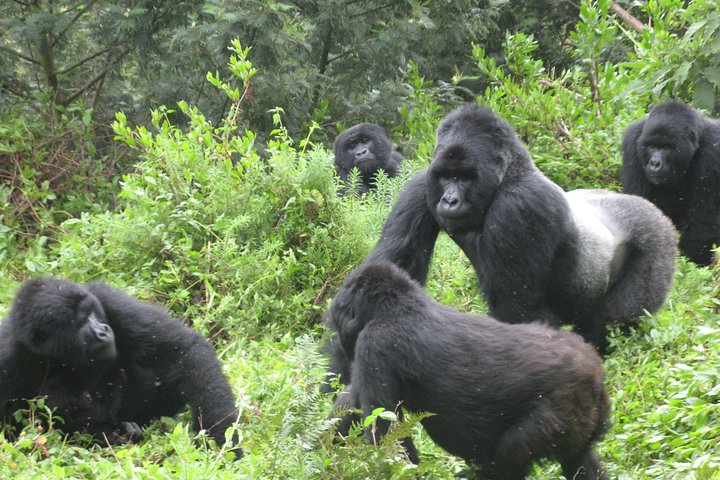All About Gorilla Trekking In Uganda
Gorilla trekking in Uganda is a thrilling and unforgettable adventure that allows visitors to get up close and personal with endangered mountain gorillas in their natural habitat. Uganda is one of the best places in the world for gorilla trekking due to its diverse and rich ecosystem, home to over half of the world’s remaining mountain gorilla population. Here’s a comprehensive guide to gorilla trekking in Uganda:
Location
Gorilla trekking takes place primarily in two locations in Uganda; Bwindi Impenetrable National Park and Mgahinga Gorilla National Park. These are further divided into five gorilla trekking sub-locations known as sectors. Four of the gorilla trekking sectors are found in Bwindi’s impenetrable national park. That Buhoma, Rushaga, Ruhija and Nkuringo sector.

Permit and Regulations
Gorilla Trekking Permit: A gorilla trekking permit is required to visit the gorillas in any of the two gorilla national parks in Uganda. It’s essential to note that permits are issued on the basis of sectors, not the national park. For instance, a Ruhija permit in Bwindi impenetrable national park cannot be used to trek gorillas in the Buhoma sector of the same national park.
Cost: The cost of a gorilla trekking permit varies according to the individual’s citizenship. For instance, East Africans pay Ugx 250,000, foreign residents pay $700 per permit and non-foreign residents pay $800 per permit.

Gorilla Habituation Experience – Bwindi National Park – Uganda
There are also permits known as gorilla habituation permits that go for $1500 per permit. This kind of experience is mainly for individuals to have a behind-the-scenes experience of how gorillas start allowing human beings in their natural environment.
Regulations: Trekkers must follow strict rules to ensure the safety of both visitors and gorillas. These may include group size limits, maintaining a safe distance, no flash photography, and a limited time with the gorillas.
Gorilla Population
Many people tend to ask about how many gorilla families are found in both Bwindi Impenetrable National Park and Mgahinga National Park. According to the last census that was conducted close to five years ago, there were 310 gorilla families in Uganda amounting to a total of 469 mountain gorillas in Uganda. These facts have changed in the last four years since more than 20 babies have been registered in the last four years.
Preparation
Physical Fitness: Gorilla trekking can be physically demanding, involving hiking through steep and dense terrain. It’s essential to be in good physical shape to fully enjoy the experience. Always seek professional advice about the sector that will likely fit your physical state.
Clothing and Gear: Wear sturdy hiking boots, long trousers, and a long-sleeved shirt. Shorts are also fine though they make exiting the forest without scratches inevitable.
The Trek
Guides and Trackers: Your trek will begin with a briefing from the lead game ranger who will also double as your tour guide. A number of the rangers will be armed with AK47s. This is not because you expect to meet any rebels in the forest; the guns are often used to make scary gunshots in case any animal attempts to attack during the trek. The most scary of all animals are the wild forest elephants.
Duration: Your trek will take between 3 hours and 6 hours depending on the sector you are in and how close the gorillas are to the park offices.
Encountering the Gorillas
Observing the Gorillas: Once you reach the gorillas, you’ll spend a maximum of one hour observing and photographing them from a safe distance. Silence is an essential requirement for the safety of everyone in the group
Behavior: Habituated mountain Gorillas are accustomed to human presence but it’s crucial to follow the gorilla trekking guidelines that also include but are not limited to maintaining a respectful distance.

Gorilla Tracking – Bwindi National Park – Uganda
Conservation and Community Involvement
Community Benefits: Gorilla trekking helps generate revenue for local communities by providing budget accommodation to tourists, selling art and craft items, acting as porters as well and getting an annual 10% cash back from Uganda Wildlife Authority.
Gorilla trekking has supported a number of conservation initiatives, anti-poaching efforts, community development, and supporting local education and healthcare.
Best Time to Visit
Dry Season: The best time for gorilla trekking is during Uganda’s dry seasons, from June to August and December to February when the trails are more accessible.

Other Wildlife and Activities
Uganda offers a range of other wildlife experiences and activities, including safari tours to see various animals, birdwatching, hiking, and cultural encounters with local communities.
Gorilla trekking in Uganda is among the most unique forest experiences in the whole world providing visitors with a unique opportunity to connect with one of our closest relatives in their natural habitat while contributing to their conservation. It’s important to prioritize responsible and sustainable tourism to ensure the long-term protection of these incredible animals and their habitats.

 Previous Post
Previous Post Next Post
Next Post